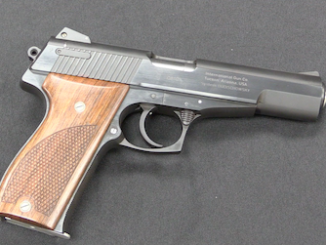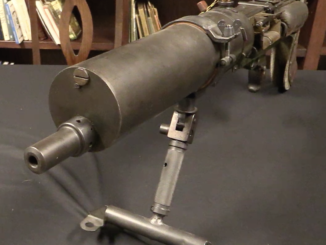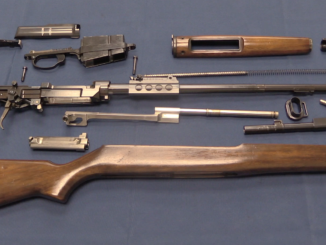Unusual German Field Gun Action
From Sam:
I saw this artillery piece in file footage of the Norwegian campaign of World War 2 and it piqued my interest due to its method of operation.However, I could not find any information on it I’m curious as to what it is, and any information about it would be much appreciated. (Skip to 0:45 see the gun in question – Ed.)
That is a 7.5 cm leichtes Gebirgsinfanteriegeschütz 18, aka 7.5cm GebIG 18 (75mm Light Mountain Infantry Gun). It was a field gun designed to be broken down into man-portable (barely) sections for transport without vehicles or animals (it was the lightened version of the design). Design work began in 1927 at Rheinmetall, and the “18” designation was chosen to hide the state of arms development and imply that it was designed during WWI (see my post on German machine gun nomenclature for more on this).
The unusual action that is shown so well in the video is an example of innovation for innovation’s sake – it really didn’t convey any particular advantage. Basically, the whole barrel pivots up away from the breechblock to eject and load, much like a break-open shotgun. Just a different way of accomplishing the same thing as a vertically or horizontally sliding breechblock.
Viking SOS 12ga Shotgun
From Thomas:
Its a 3 inch magnum and it says made in Italy that’s all I know just wondering if you’ve seen anything like it before and if you have any information on it . thanks for your time.

Milsurp Parts Sources
Hello Forgotten Weapons, I have a sort of general question here, where are the best places to buy spare parts for old Milsurp rifles? I love Milsurp but there are often crucial pieces missing that I worry about not being able to find/buy. I see parts at gun shows and sometimes online, but I was wondering where your favorite places are to get parts for old Milsurp?
In general, my first stop for random gun parts is Numrich. They have by far the widest selection of parts, from barrels and magazines to all the little things like screws and springs. Most parts suppliers buy batches of things that become available and stock them until they run out, but Numrich is constantly buying incomplete guns and small batches of parts and maintaining a huge stock. However, they focus as much on commercial sporting guns as military ones, and they don’t always have the more military-flavored accessories or large assemblies.
If Numrich doesn’t have what I’m looking for, I will check with a couple go-to companies that focus more on military items, like Apex Gun Parts and Allegheny Arsenal. These folks don’t have the massive inventory that Numrich does, but they do have a much more focused knowledge of their stock and are much better able to address questions like finding a part to match a specific variant of a military weapon. Some other companies in this group would be Sarco, Liberty Tree Collectors, RTG Parts, and Northridge.
My third stop after those folks would be GunBroker and eBay, to see if anyone just happens to have what I need. I will also simply do a Google search for the part, because sometimes a small company I’ve never seen before will have brought in a pallet of surplus Norwegian barrel band connector springs or whatever and nothing else.
Have a question you’re curious about? Drop me a line at admin@forgottenweapons.com!




Interesting that a clip supposed to show fighting in Narvik (which happened in 1940) has a MG 42 in it.
Heh – good point! I hadn’t thought about that.
My guess would be that the footage is actually from the Caucasus in ’42.
If the film was made at Narvik and if my memory serves me right it is possible that the machine gun was the MG39/40 which was the trials version of the MG42 before it was officially issued as the MG42.
http://www.s323692152.website-start.de/ersatzteile/
This is a link to a very trustworthy German dealer in, amongst other things, a lot of gunparts. I got a C96 part there.
With regards to FABARM, don’t forget that HK USA once imported their shotguns. This was after Beretta bought Benelli.
Don’t forget Springfield Sporters, I’ve gotten a couple of things from them over the years.
“the “18″ designation was chosen to hide the state of arms development and imply that it was designed during WWI”
Wait, people actually did this? So do you mean to tell me every gun name ever might be a blatant LIE? 😀
I think that Ruger admits as much about the model 77 bolt action.
The main competitors weere the Rem 700 and Win Mod 70, there was no way that the Ruger gun was going to escape from the factory without at least one number 7 in its name.
According to John Walter in The Guns of the Third Reich, practically every German armaments project in the 1919-33 time frame had a number intended to make the Allies assume it dated to before the Armistice. For instance, the MG13, which was developed by Mauser engineers at Solothurn in Switzerland in 1922-24, or the MP28 SMG, which was originally designated the MP18.2. (In its case, it was probably justified, as the only real difference between the two was the magazine interface and a fire-selector.)
Incidentally, the IG-18’s “break-action” breech setup also showed up on at least one experimental German recoilless AT gun prototype. Production models, however, more sensibly had either sliding-block breeches or simply had the breech and venturi assembly swing to one side, rather like the later Swedish Karl Gustaf 84mm RCL.
cheers
eon
vid about the german gun https://www.youtube.com/watch?v=8t_UbfYWh6E
You might also give Jeff Lee a call for gun parts. He is a great guy to deal with.
http://www.leesgunparts.com/
Sarco is another excellent source of surplus gun parts, not quite on the level of Numrich, I think, but very good. http://www.e-sarcoinc.com/
I’d almost forgotten about the “Viking”. They came into Britain at the time that practical shotgun was taking off in the early 80s. I only remember seeing the pump version.
It’s unique selling point and (in my personal opinion) the worst thing about it was the straight line stock.
It might have allowed faster follow up shots, but for people like me who were used to a lower sight line, I found it slower to get lined up for the first shot.
They seemed to be sound enough guns mechanically.
cant find post to send you question so ill post my question about italian firearms here if i may.
i was wondering if anyone can explain me something about italian hmg breda 37. i cant find this data anywhere. im from slovenia where region i live in was ocupided by italian during ww2 and there for when italian were retreting they left all their equipement here. folks around took that equipement and you it as it fit them to their live stile. most common thing for them to take were hmg breda’s 37 and for the reason of “watter proff” rust resistant barrel, and the fact there was a lot of amunition for that machinegun. people here were using this barrels to make their own hunting rifles as none were around because partisan took them for their needs. what i heard interesting about those barrels is that the thread inside the barel was geting “dense”/denser, from the start of the barrel to the end. there for i would dlike to ask you if anyone can explain it to me why? whoever i ask, noone knows as for why this dense threads inside the barrel were made to go from less to moar at the end of barrel.
I just found a 37mm round that had belonged to my father-in-law. It seems to be manufactured in France during WWI and bears the following inscription: GUERRE . 1914 . 1918; 37 – 85 PPDs 296 1 . 18. It’s 7 inches tall. I know nothing about munitions, and I’m wondering how I can tell if it’s been deactivated and/or if it’s safe and what do you recommend I do with it. Unfortunately, my father-in-law passed away many years ago and I can’t ask him. Thanks for any information you might be able to pass on to me.
I have a question for Ian: I am an engineering student in college, and am having difficulty understanding the application of higher level calculus (Differential Equations and Multivariable Calc). In your time in manufacturing, what did you find yourself using calculus for, and how would you apply it to solving problems?
I have acquired an obscure French 14mm/32 gauge bolt action shotgun, single shot. I have not been able to find much of anything on the net about it. It was manufactured by ManuFrance, using a patent of Pierre Blanchon. Blanchon and Entienne Mimard started their company, ManuFrance in the late 1800s. I need to find a list of MF proof marks that correspond to the ones on my shotgun to determine if it is proofed for nitro powder or black powder, and possibly date her. She is quite the petite beauty and and may be in the garden gun category. I would like to shoot her if I can find out want she safely likes to eat. How can I post photos of her on here?
ManuFrance is a good company!
I’m a history enthusiast, and it seems to me that this rifle has a cool design for mobility and convenience. Do you know any similar examples? Don’t judge me too harshly; I’m learning for myself and helping kids with assignments. My historical pursuits end here.